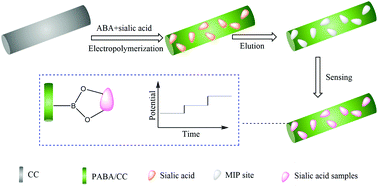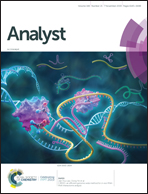Potentiometric analysis of sialic acid with a flexible carbon cloth based on boronate affinity and molecularly imprinted polymers
Abstract
An electrochemical platform was proposed for highly sensitive and selective analysis of sialic acid based on molecularly imprinted polymers (MIPs), which were electropolymerized with the monomer molecules of 3-aminophenylboronic acid (ABA) on a carbon cloth (CC) electrode in the presence of template molecules. The fabricated sensor, named the PABA/CC-based MIP electrode, could be used for the detection of sialic acid because the reversible and covalent boronic acid–diol binding was sensitive to the electrochemical potential of the prepared sensor. The utilization of a CC film as the substrate could improve the sensitivity due to its good electrical conductivity and large surface area. Under the optimized conditions, a good relationship between the change in potential and the concentration of sialic acid was obtained in the range from 40 μM to 440 μM with a detection limit of 0.5 μM. The resulting MIP sensor also displayed good selectivity, reproducibility and stability. Moreover, this sensor was successfully applied for the evaluation of the sialic acid level in infant formulas.



 Please wait while we load your content...
Please wait while we load your content...